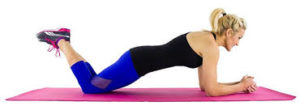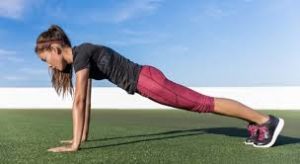What is a Plank?
A plank is a simple bodyweight exercise that requires no equipment, and can be performed anywhere (using your best judgment!). This isometric core exercises requires you to maintain a position similar to a push-up for a maximal time.
Benefits
This simple exercise has multiple benefits. When planking you are first holding yourself up using your arms, which is allowing your shoulders, biceps, and triceps to work, so the muscles of the arms are being toned and developed. Moving down to your midsection when you successfully perform this exercise you are also activating and developing your glute muscles. Lastly, not only are your arms are developing in this exercise, but also your thigh muscles are developing because you are using the weight of your body to stay balanced!
Improve Core Definition
Planks are ideal for abdominal exercises because they engage all of the muscle groups involved in the core area.
Improving these muscle groups’ strength and stability can have a number of benefits, including the following examples:
Rectus Abdominis- improved sports performance
Transverse Abdominis- ability to lift heavier weights
Oblique Muscles- improved capacity of lateral bending and torso rotation
Glutes- supported lower back and stronger booty
Health Benefits
Benefits
This simple exercise has multiple benefits. When planking you are first holding yourself up using your arms, which is allowing your shoulders, biceps, and triceps to work, so the muscles of the arms are being toned and developed. Moving down to your midsection when you successfully perform this exercise you are also activating and developing your glute muscles. Lastly, not only are your arms are developing in this exercise, but also your thigh muscles are developing because you are using the weight of your body to stay balanced!
Improve Core Definition
Planks are ideal for abdominal exercises because they engage all of the muscle groups involved in the core area.
Improving these muscle groups’ strength and stability can have a number of benefits, including the following examples:
Rectus Abdominis- improved sports performance
Transverse Abdominis- ability to lift heavier weights
Oblique Muscles- improved capacity of lateral bending and torso rotation
Glutes- supported lower back and stronger booty
Health Benefits
- Decreased risk for injury of the back & spinal column
- Boost in metabolism
- Improved posture
- Improved overall balance
- Improved flexibility
- Improved mental state
How to Perform a Proper Plank:
- Plant your hands directly under the shoulders (slightly wider than the shoulders) like you’re about to do a push-up.
- Ground through the toes into the floor and squeeze glutes to stabilize your body. Your legs should be working too, but be careful not to lock or hyper-extend your knees.
- Keep the neck and spine neutral by looking at a spot on the floor about a foot beyond your hands. Your head should be in line with your back.
- Hold this position
Plank Variations:
By: Olivia Callan
Health Fitness Specialist Corporate Fitness Works
JOHO Fitness







